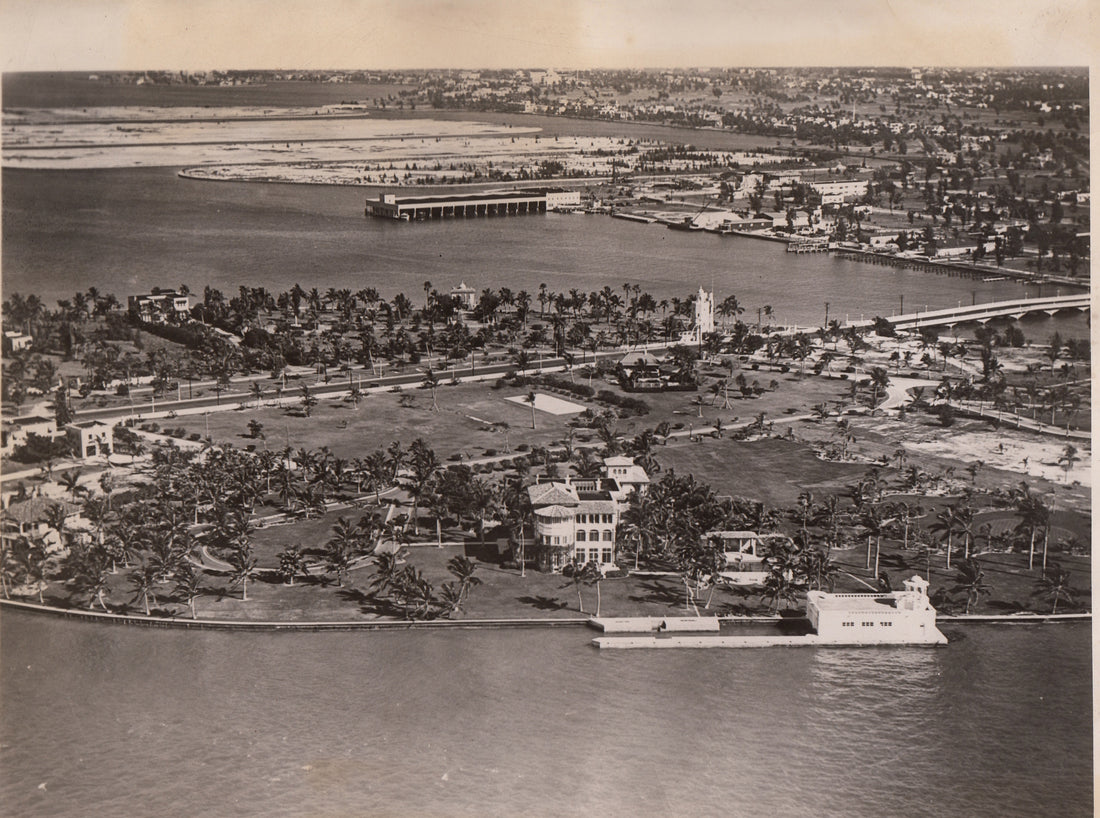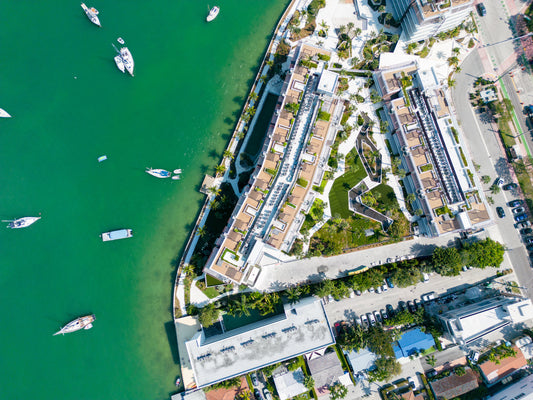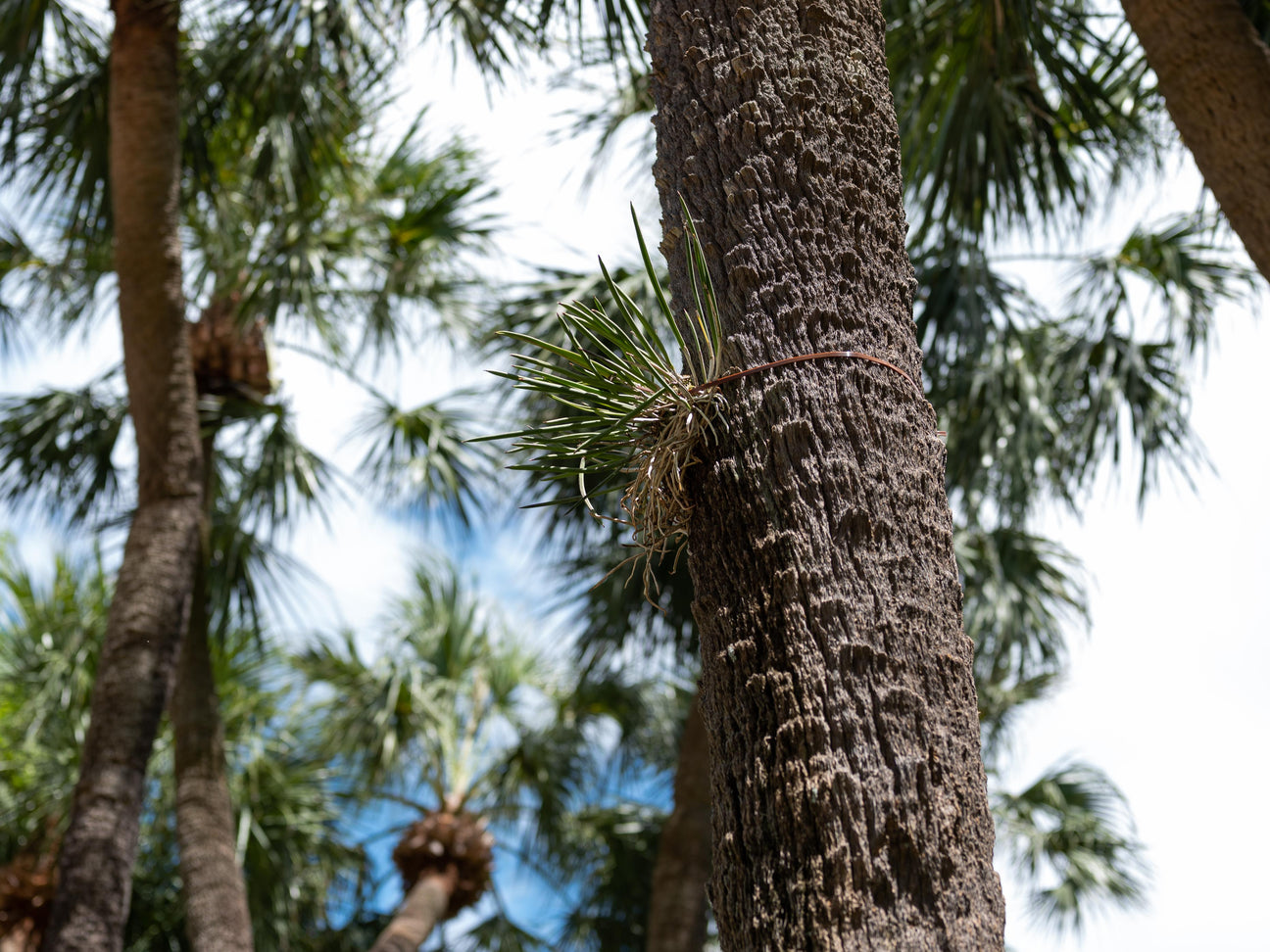
If you have information or a contribution to our timeline, please don’t hesitate to let us know. We are always learning about and from our past.
1911
Local fruit farmer John Collins, who owned large tracts of land on the barrier island that was to become Miami Beach, was convinced that others would come to appreciate the wonderful climate, beaches and waters of the barrier islands as he did. In order to bring people to his property, he initiated a bridge building project across Biscayne Bay. When Collins ran short of funds ran to complete the bridge, Collins turned to automotive and real estate investor Carl Fisher to borrow money to finish the project.
1913

When Collins’ bridge opened on June 12, the wooden toll bridge traversed Biscayne Bay from Miami at its West end, crossed Bull Island (renamed Belle Isle) and terminated on the shores of the future Miami Beach. At the time, it was called “the longest wooden bridge in the world.” John Collins proudly called the bridge Collins Bridge.
1921

Retailing giant J. C. Penney bought a prime parcel on Belle Isle at 8 Island Avenue – the site of the future 9 Island Avenue condominium.
He called the estate White Haven.

In the aerial photo below, taken in the early 1920’s, Penney’s house can be seen. None of the Venetian Islands have been created at this point.

The 1923 aerial photo below shows Rivo Alto Island now created but not yet built on. Hibiscus Island, on the far left, is about to be filled in. The Flamingo Hotel is also on the left.

1924
Joseph H. Adams, a New York inventor and author, came to Florida.
According to an obituary in the New York Times, Adams made his fortune creating oil processing machinery. Adams built an estate at 18 Island Avenue, on the land where the present day Belle Plaza and Belle Towers buildings now sit.
In the aerial photo below, taken in 1929, the eastern bend in Island Avenue is visible. Adams’ main circular driveway is roughly where Belle Plaza’s is now. The land where Adams’ pool and guest house (on the lower right) were later sold and became Belle Towers.

1925
After additional islands (with names evocative of the islands of Venice) were created off Collins Bridge, the bridge was replaced in 1925. The new series of arched bridges and drawbridges connecting the islands was renamed the Venetian Causeway.
1929

US President-elect Herbert Hoover stayed at J.C. Penney’s White Haven for four weeks.
According to research by Belle Isle Blog, the invitation was extended as a way to bring notoriety to Penny’s home for a possible future sale. Hoover used one of the houses on Joseph Adams’ estate as an office and staff and reporters also used the property while Hoover was in residence.
Notorious 20’s gangster Al Capone owned a home at 93 Palm Avenue on Palm Island. An oft-repeated story is that because Hoover’s nights were disturbed by Capone’s loud parties, Hoover decided to take revenge and directed the Federal authorities to pursue Capone’s illegal activities. Author and Capone expert Jonathan Eig was quoted in a 2012 Miami Herald story as saying he had not found any evidence to confirm the story.
Because of Hoover’s visit, many photos of Belle Isle were provided to newspapers across the country. Below is an aerial view of the Adams’ estate in the foreground and Penney’s white house in the upper part of the photo.

Below is an Associated Press photo showing Adams’s guest house seen in the upper right of the photo above.
The caption on the back of the photo mistakenly identifies the house as part of the J.C. Penney estate.
It reads: “HOOVER’S TEMPORARY OFFICE – This small residence on the estate of J.C. Penney, at Belle Isle, Fla., will be the temporary private office of President-elect Herbert Hoover. In it is likely the inaugural address of the new President will be prepared and from it probably his cabinet announced.”

An aerial view of Adams’ estate (below) was also released by AP in 1929. The caption on the back reads: “PRESIDENT-ELECT’S VACATION HOME – This is an excellent panoramic view of Belle Isle, Fla., where President-elect Hoover and his party are spending their preinaugural vacation. The photograph was taken from the roof of the Flamingo Hotel at Miami Beach. Belle Isle contains the estate of J.C. Penney, owner of a national chain store system, which tendered to the next President. It is here that it is expected that Mr. Hoover will put into final shape his inaugural address.”
Note the twin tower-like structures near Venetian Way.

Another AP photo (below) released for Hoover’s 1929 visit, shows the J.C. Penney estate and Belle Isle.
Of note is a house standing on what appears to be the 36 Island Avenue property where Island House now stands. To the east, a pavilion-like structure sits on the bay on the future site of the Belle Isle Key Apartments. Another house appears where the municipal pump station now sits in Belle Isle Park. Nearby is what could be a tennis court. The Sunset Islands have been created but not yet built on.

Another view of Belle Isle below. This was probably taken after the above photograph since it appears there are now two tennis courts in the middle of the future Belle Isle Park. Also visible is the property that Belle Isle Key Apartments now stands. It appears to be a park of some kind. At that point, only large private homes occupied the rest of the island.

The below postcard is dated 1930.

1931
Penny sold his estate for $150,000. Belle Isle Court Apartments (later renamed Belle Isle Key Apartments) were built at 31 Venetian Way. With the advent of World War II, the US Army commandeered the complex to house troops stationed in Miami Beach.
1939

In 1939, Joseph Adams published a brochure touting “The Belle Isle Sun-Ray and Health Spa.” The brochure (below) calls Adams the director of the spa and a “pioneer American Sun-Ray Scientist” and invites readers to visit the spa to sample “the most up-to-date Heliotherapy and Hydrotherapy treatments.”
1941


Joseph Adams died in his Brooklyn, New York home at the age of 74. An obituary in the New York Times, published on February 10, called Adams an author and “inventor of an oil-cracking process that is regarded as a basic patent.” The article says Adams obtained his patents in 1919 and “the patents are currently controlled by the Texas Company and Standard Oil of Indiana.”
Adams’ Miami connections are described: “Dr. Adams went to Florida in 1924 and became interested in the University of Miami. He received an honorary Doctor of Science degree from that University in 1928. He maintained a Winter home in Miami and visited the resort every year.”
Adams is also described as having “belonged to a committee of 100 prominent residents of Miami, organized in 1931, to rid the city of gambling.”
Also in 1941, All Souls Episcopal Church leased Adams’ house and used the music room as a 300-seat sanctuary. According to the church’s website, the first service was held in February, 1943. The parish moved to its present Pine Tree Drive
Adams is also described as having “belonged to a committee of 100 prominent residents of Miami, organized in 1931, to rid the city of gambling.” Also in 1941, All Souls Episcopal Church leased Adams’ house and used the music room as a 300-seat sanctuary. According to the church’s website, the first service was held in February, 1943. The parish moved to its present Pine Tree Drive church in 1954.
1943
The University of Miami established the UM Marine Laboratory. According to university records, the lab was housed in Joseph Adam’s boat house. In 1945, the boat house’s pilings collapsed and the staff moved to Coral Gables. The Marine Lab eventually became the Rosenstiel School of Marine & Atmospheric Science.
1953
The Monterrey Hotel, on 2.5 acres, was opened at 40 Island Avenue. Originally designed by Norman Giller, A. Herbert Mathes was the architect for a major reconstruction in 1960 that transformed it into the Lido Spa.
In “MiMo. Miami Modern Revealed” by Eric P. Nash and Randall C. Robinson Jr. (Chronicle Books, 2004), the authors called the building “Resort MiMo playing at Subtropical Modernism.”
They recall the Lido Spa of years gone by: “In its spa incarnation, the Lido was one of the last holdouts of the Borscht Belt on the Beach. For nearly forty years, it catered to a dedicated clientele of Jewish ladies of a certain age, complete with canasta, kosher meals, and the silken strains of the Hy Siegel Orchestra on Saturday nights.”
Below is a postcard from 1954 touting the Monterrey Resort Motel.
The caption on the back reads: “MONTERREY Resort Motel. Belle Isle. Venetian Causeway. Miami Beach. Just minutes from Lincoln Road. Uncongested Central Location…350 Feet of Water frontage…Swimming Pool…Water Skiing…Fishing…Boating…Hotel Rooms…Kitchen Apartments…24 Hour Telephone Service…Free Individual Parking…Air Conditioned and Heated."

A brochure for the Monterrey calls it “The Resort of Tomorrow.”


1958
Belle Towers, 16 Island Avenue, was completed.
On the original documents that later converted the building to a condominium, Nathan and Minnie Manilow and Harry and Frances Nathenson are credited as developers of the 47-unit rental building.
Nathan Manilow was a successful developer from Chicago who also lived in Miami Beach. His notable real estate ventures included the massive planned community of Park Forrest, Illinois and Jeffrey Manor in Chicago. He was also a major donor to charities in both Chicago and Miami.
An October 5, 1967 Miami News article focused on Manilow’s latest project, the Sheraton Four Ambassadors apartment and hotel complex on Biscayne Bay in Miami. The report notes Manilow “built Miami Beach’s first luxury high-rise, The Belle Towers.”
Belle Towers’ architect was Robert Swartburg, the designer of the famed Delano Hotel on Collins Avenue. There were 46 apartments plus one unit for the building manager. Originally built as a rental building, the property was converted to condominium ownership in 1971.
In “Miami Architecture. An AIA Guide featuring Downtown, the Beaches, and Coconut Grove” by Allan T. Shulman, Randall C. Robinson Jr. and James F. Donnelly (University Press of Florida, 2010), the authors make note of Belle Towers:
“The first apartment tower on Island Avenue, Belle Towers was an avatar of the midcentury apartment-tower boom that would transform coastal Miami. The shamrock-shaped apartment block offers multiple fronts and view-multiplying potential. An open-air lobby punches through the building and functions as a grand breezeway, offering spectacular views from the drop-off to Biscayne Bay. The indoor-outdoor space of the breezeway is a subtropical wonderland of landscaped islands and amorphous pools (well stocked with fish, turtles and, anecdotally, at one time an alligator). The brick walls on either side are adorned with bas-relief panels and hanging planters. Visitors rise over the pools on elegant serpentine ramps that penetrate to the building cores on either side.”
1962
3 Island Avenue, named Terrace Towers Apartments, was completed.
Designed by Morris Lapidus, widely acclaimed architect of many Miami Modern masterpieces, the building is a rare cooperative-owned building. Lapidus and his wife lived in a penthouse apartment for many years.
“Miami Architecture. An AIA Guide featuring Downtown, the Beaches, and Coconut Grove” by Allan T. Shulman, Randall C. Robinson Jr. and James F. Donnelly (University Press of Florida, 2010) describes Terrace Towers:
“Lapidus’s touch is visible in the cantilevered folded-plate concrete canopy at the automotive drop-off as well as in the 2-story lobby.”
In the image from the below postcard, which was likely taken right after the completion of Terrace Towers, several notable additions are visible. A two-story residential building has been built where The Vistas now stands and Venetian Isle Resort Motel is seen where the Grand Venetian is today.

Below, aerial views from the north and south after Island Terrace was completed.


Belle Plaza at 20 Island Avenue, originally opened as a rental building. It is also considered completed in 1962.
T. Trip Russell and Associates was credited as architect.
An entry in “Miami Architecture. An AIA Guide featuring Downtown, the Beaches, and Coconut Grove” by Allan T. Shulman, Randall C. Robinson Jr. and James F. Donnelly (University Press of Florida, 2010), describes the building:
“The chevron massing of this apartment tower is reiterated in exquisite boomerang-themed balcony rails of precast concrete. Other Modernist forms are arranged in front: a convex concrete shell forms the entrance porte-cochere, and a separate but equally futuristic-looking structure is the parking garage. The tower façade exhibits strong horizontal banding accentuated by partly recessed balcony areas and awning windows. The horizontality is interrupted by the solid building core, which is sheathed in mosaic tiles that lighten as they rise.”
The series of aerial photos below were probably taken between 1963 and 1966.

Clearly seen in the below photo is a low rise building that occupied the future home of Costa Brava at 11 Island Avenue.


1967
Island Terrace (5 Island Avenue) was completed. Also designed by Morris Lapidus.
1969
Island House (36 Island Avenue) is opened as a rental building. It contains 30 units and is 5 stories tall.
1972
Costa Brava (11 Island Avenue) opened.
1981
9 Island Avenue was completed. With 25 floors and 247 units, it became the largest building on the island. The Simkin family was developers of the building.
1998
The Vistas (1 Century Lane) opened.
2001

The Grand Venetian (10 Venetian Way) was completed. Designed by prolific local architect Kobi Karp, the building is notable for its wide warp terraces and intimate feel. It stands on the site of the 1950s era Venetian Isle Motel that was demolished years before.
2004
Belle Isle residents meet in December to form a new association to maintain the quality of life of the island. Of particular concern is the pending opening of the Standard Hotel in the former Lido Spa complex and plans for renovation of the city’s park in the middle of the island.
2005
The first formal meeting of the Belle Isle Residents Association took place on January 19. The members of the first board of directors were: Herb Frank, Barbara Frank, Josh Fisher, Keith Hark, Michael Glogower, Nancy Liebman, Luis Marcelin, Henry Mistre and Sandy Paul.
Also in 2005, the Standard Hotel, headed by Andre Balazs, opened in the newly renovated Lido Spa. Architect Alison Spear is credited with the renovation.
2008
Belle Isle Park is re-opened after an extensive renovation by the City of Miami Beach. Featuring lush landscaping, meandering sidewalks and a dog park, the new park is an instant hit with residents in the surrounding buildings and neighborhoods.
2009
The Belle Isle Blog first appears on-line on December 15.
The blog features news about Belle Isle and surrounding areas.
Its first scoop was a sighting of music star Queen Latifah driving on Venetian Way in a convertible blue Bentley. It went on to cover more serious issues – including the island’s flooding problems and a proposal to demolish the Belle Isle Key Apartments and replace them with a larger structure. It became a must read for residents of Belle Isle and Miami Beach.
2011
Miami New Times named Belle Isle “Best Hidden Neighborhood.”
The newspaper said of Belle Isle: “…it marries the Venetian’s quiet, exclusive vibe with a more bohemian, South Beach cool. Sure, there are million-dollar luxury lofts in the eye-popping Grand Venetian, but there are also charming, squat waterfront apartments that once housed military barracks and quiet, sandy lanes with palm-shaded one-bedroom houses. The island’s center is a newly renovated park, and a footpath on the perimeter leads to clear-water views of Biscayne Bay reefs. Just to top it off, Belle Isle is home to hipster paradise the Standard, an über-chic hotel with South Beach’s best spa, an Anthropologie-approved lounge, and the Lido Restaurant, a vegetarian-friendly eatery with ridiculous bayside table views. Next time you’re in SoBe, take the hike across the bridge — your new favorite neighborhood has been hiding in the middle of the bay all this time.”







